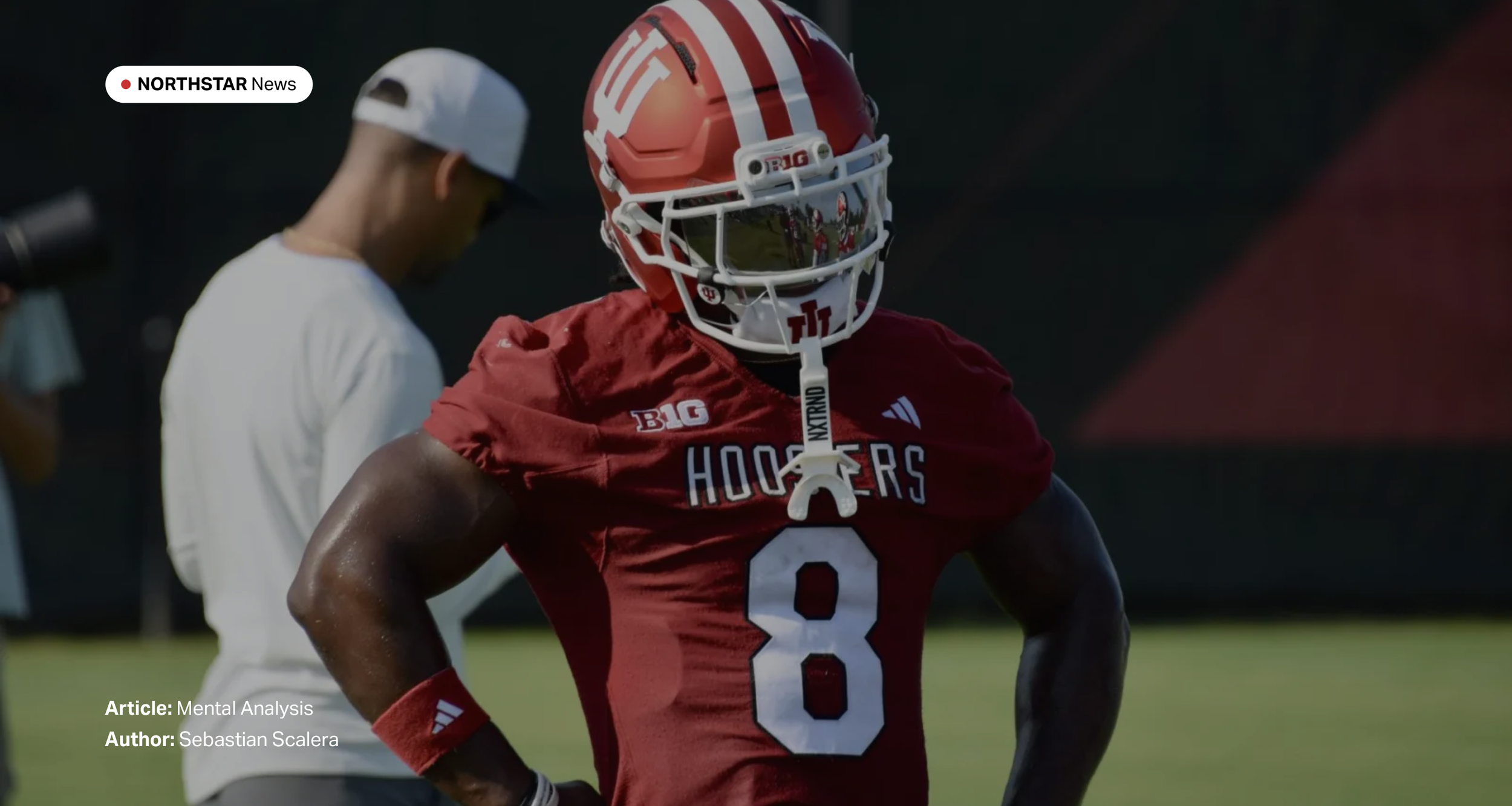How Indiana Embraces the Chip on Their Shoulder—And How You Can Too.
Running Back Kaleon Black scans the field between practice reps at Fall camp. (Photo by Seth Tow for TDH).
Last year, Indiana football kicked the door open.
They weren’t just a Cinderella story—they rewrote the script.
But here’s what matters more than the wins: they kept the chip.
“Last year, a lot of us went into it with a chip on our shoulder that we do belong,” said linebacker Aiden Fisher. “This year is going to be the same thing, but it’s more about that we can dominate this level.”
For high performers—from athletes to artists to entrepreneurs—the “chip” is more than motivational fluff. It’s a real psychological construct: a fusion of identity, memory, and internal drive that sustains performance long after the spotlight moves.
And the best part? You don’t need to play D1 football to use it.
The Chip = Internalized Fuel
Most people start with extrinsic motivation—proving doubters wrong. But that fire burns out fast.
The best performers, like Indiana, transmute that chip into something deeper: intrinsic motivation, the kind that lasts.
“It’s always been about us,” Fisher said. “What can we do better?”
🧠 The Research
According to Self-Determination Theory, people thrive when three psychological needs are met: autonomy, competence, and relatedness (Ryan & Deci, 2000).
When athletes are driven by these factors—not just external pressure—they show greater resilience, better emotional regulation, and long-term success.
Source: Ryan, R. M., & Deci, E. L. (2000). Self-determination theory and the facilitation of intrinsic motivation, social development, and well-being. American Psychologist, 55(1), 68–78.
💡 How You Can Build Your Own Chip
You don’t need to be a linebacker to turn resentment into results. Here’s how to do it—with science on your side:
1. Anchor the Chip in Identity, Not Ego
Kamara’s motivation isn’t about headlines—it’s about unfinished business.
“Even if you look at IU’s history, there’s glimpses of good seasons, followed by four bad ones,” Kamara said. “I want to make sure we’re only going to continue to elevate.”
This is a key shift from ego involvement (validation-driven) to task involvement (process-driven), which is linked to higher persistence and performance (Duda & Nicholls, 1992).
Source: Duda, J. L., & Nicholls, J. G. (1992). Dimensions of achievement motivation in schoolwork and sport. Journal of Educational Psychology, 84(3), 290–299.
2. Use Visualization to Weaponize Focus
Kamara literally wallpapers his goals:
“Oregon and Penn State—they’re circled and starred. It’s on my phone wallpaper.”
This isn’t superstition. It’s a technique called Episodic Future Thinking—mentally simulating future scenarios to prime the brain for high-stakes performance. Studies show it boosts motivation, focus, and even decision-making under pressure (Schacter et al., 2008).
Source: Schacter, D. L., Benoit, R. G., & Szpunar, K. K. (2008). Episodic future thinking: Mechanisms and functions. Current Directions in Psychological Science, 17(4), 219–223.
3. Surround Yourself With Standards, Not Just Support
The real secret to Indiana’s rise? Cultural cohesion.
“It’s about the people in the building,” Fisher said. “So just keeping that mindset … and eliminating clutter outside of it.”
That’s not just talk. Research shows that task cohesion—shared goals, values, and commitment—is a stronger predictor of team success than talent alone (Carron, Bray, & Eys, 2002).
Source: Carron, A. V., Bray, S. R., & Eys, M. A. (2002). Team cohesion and team success in sport. Journal of Sports Sciences, 20(2), 119–126.
4. Don’t Just Remember the Win—Remember the Scar
Indiana still remembers how it ended.
“You have to keep working,” Kamara said. “The days you don’t want to work are the days you really have to do it.”
That’s emotional encoding at work—psychological resilience built by framing painful moments as fuel. Athletes who reflect on setbacks with intention (vs. avoidance) show greater mental toughness and comeback ability (Crust & Clough, 2011).
Source: Crust, L., & Clough, P. J. (2011). Developing mental toughness: From research to practice. Journal of Sport Psychology in Action, 2(1), 21–32.
Make It Yours
Missed the promotion? Circle it.
Got ghosted on your project pitch? Star it.
Still haven’t made the varsity team? Wallpaper it.
Now build a system so strong that you don’t need the noise.
THE BOTTOM LINE
Indiana doesn’t just have a chip. They use it.
Not to prove people wrong, but to prove themselves right—again and again.
“We’re not looking to sustain it,” said Coach Cignetti. “We’re looking to improve it.”
That’s what the chip is really about. Not resentment. Not revenge.
But relentless improvement—driven by belief, built in community, and powered by science.
So the next time someone doubts you?
Thank them.
Then get to work.
Research Sources
Ryan, R. M., & Deci, E. L. (2000). Self-determination theory and the facilitation of intrinsic motivation, social development, and well-being. American Psychologist, 55(1), 68–78.
Duda, J. L., & Nicholls, J. G. (1992). Dimensions of achievement motivation in schoolwork and sport. Journal of Educational Psychology, 84(3), 290–299.
Schacter, D. L., Benoit, R. G., & Szpunar, K. K. (2008). Episodic future thinking: Mechanisms and functions. Current Directions in Psychological Science, 17(4), 219–223.
Carron, A. V., Bray, S. R., & Eys, M. A. (2002). Team cohesion and team success in sport. Journal of Sports Sciences, 20(2), 119–126.
Crust, L., & Clough, P. J. (2011). Developing mental toughness: From research to practice. Journal of Sport Psychology in Action, 2(1), 21–32.
With respect to James Neveau and NBC Sports for their excellent reporting on Indiana Football.
See their article available here.
